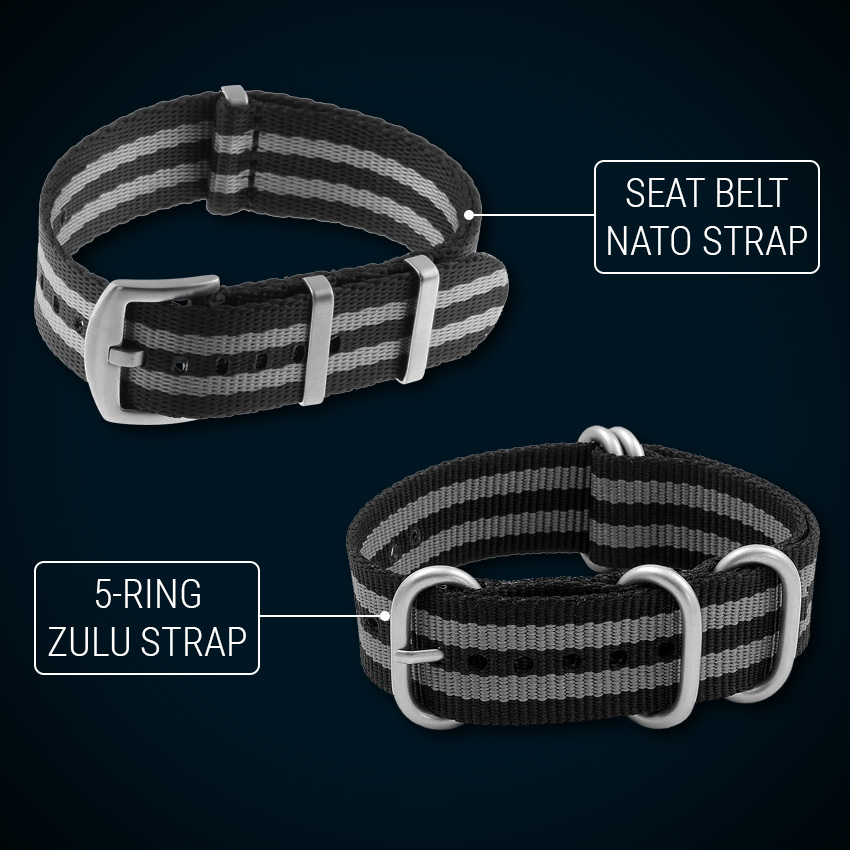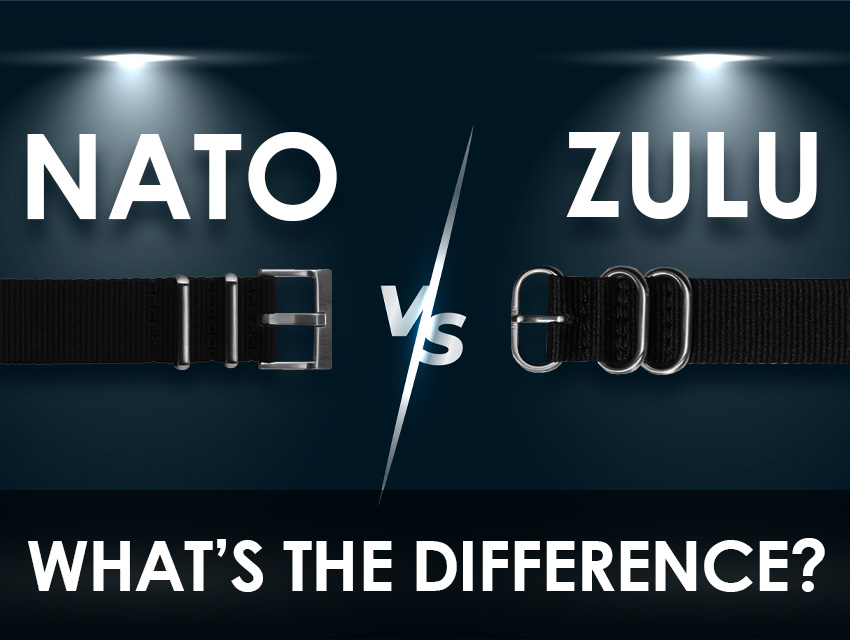NATO and Zulu straps are both common types of single-piece watch straps, so what’s the difference? That’s the question we hope to answer for your today!
Although distinct, NATO and Zulu straps do share many similarities. As mentioned, both styles feature a single-piece “pass-through” or “slip-through” design, rather than the two-piece design often found on other types of watch bands. Additionally, both styles are commonly available in similar color schemes and materials, such as nylon and leather.
Physical Differences
The most notable physical differences between NATO and Zulu watch straps are the buckles and keepers; Zulus sport a much rounder and thicker set of hardware, whereas the NATO has thinner and more rectangular keepers, as well as a Tang-style buckle.

NATO straps commonly include an additional piece of material on the underside, which serves to keep the watch on your wrist, should one of the spring bars break or come loose. Some Zulu straps include this feature as well (known as 5-ring Zulus), whereas others do not (known as 3-ring Zulus).
A Brief History
The history of the NATO strap begins in the early 1970’s when the British Ministry of Defense made these straps standard issue. The ‘G10’ nickname associated with NATO straps is a reference to the G10 form that had to be filled out in order to get one.

Although Zulu straps don’t have a well-documented military history, it is thought that they were inspired by pre-NATO single-piece straps such as the RAF (Royal Air Force) straps, similar to the one famously worn by Sean Connery’s James Bond in Goldfinger.
Are you sporting a NATO or Zulu strap with your watch? Let us know in the comments, and don’t forget to check out our NATO strap installation guide!


There are three advantages of the Zulu over the NATO, that I’m aware of.
1. Since the strap is locked into place by the double rings, it transfers the stress through the bottom strap, away from the top strap where the watch is held. This puts less stress on the spring bars, making them less likely to come out.
2. Since the strap is locked into place by the double rings, you can adjust the location slightly to accomodate in-between fits. If one whole is too small but the next one is too large, you can adjust the strap lock position to get the perfect fit.
3. Some watches, in particular, larger dive watches, have uncomfortable bottom edges which make them uncomfortable to wear. Again, by adjusting the location where the strap is locked into place, you can add a little slack to the top strap, brining the watch up off your wrist, thus making for a more comfortable to wear.
There are, in my opinion, two advantages of NATO over Zulu:
1. For some watches (excluding #3 above), the NATO is more comfortable.
2. The NATO is more attractive.
There is here a misconception that only G10s (NATOs) have the additional layer. Thought it was originally a contribution of the G10, it was also adopted by the Zulu type strap (sometimes it have them, sometimes not), reducing the difference to the buckles and keepers (also that the Zulu is usually longer). I have also seen Zulus with four rings (buckle included) instead of five.
NATO — and / or Zulu straps to me are the same type of annoying straps, save the two-piece ones, because thën one can wear a non-annoying and 100% non-sliding and nórmal feeling watchband, without being rattled by the thin nylon / resin material.
Wear a two piece strap and cry when your watch gets caught in something and you lose the whole thing, you lose a lug in a two piece and your watch falls… Yup, two piece straps are good for couch potatoes… But a NATO will keep your watch attached when one lug breaks cause you got caught in something. Rarely will two lugs give at the same time… So for active guys like me NATO for the win…
And a Zulu doesn’t have to have heavy round metal loops, thinner metal, or more originally nylon to match the band can be used. And the zulu style is also much older than the NATO or British MOD style, having been used by the US military starting at least around 1960, if not earlier. I assume the zulu name came about because of the military using zulu time (which was the same as GMT or UTC time) for all military operations, based on US phonetic alphabet designators for time zones.
By “US phonetic alphabet” you of course mean the NATO phonetic alphabet (ironic, hey?) established by the INTERNATIONAL Civil Aviation Organization?
I agree with RCR and Steve. I must also add that the second retainer of the Nato does NOT help keep the watch on the wrist in case of spring bar failure. The single pass of both strap types has that purpose (if one is broken the chain of the strap isnt broken. The retainer only keeps the watch from sliding around on the strap itself which keeps it from sliding off the strap and onto the floor if you’re not careful when taking it off the wrist
I’m with Steve. Your article didn’t quite explain it. There is a lot of confusion out there because people use both terms to describe the same band! To me, a Zulu is a “single-pass” strap of one layer of strap. A NATO is two layers between your arm and the watch.
I’ve also seen NATOs described as single-pass which I don’t like? I guess a NATO has a single-pass through the watch spring bars, but it has two layers.
Also, a Zulu, to me, has the round, heavier keepers, while the NATO has the flat, square corner keepers.
Sporting a 22mm Navy & Grey 5-stripe NATO on my PHOIBOS 1000-Meter Dive Watch.
This article is wrong. Both straps pictured in this article are NATO. Like Steve Warren stated the Zulo only has one layer under the watch where the NATO as two. The difference has to do with the strap configuration – not the hardware.
Absolutely correct!
I get it now. Nato double strap, zulu single strap. I use the double strap model for my g shock watch. It doesn’t fit. The watch is lifted too high. The single strap is more comfortable…… 🙏😎👍☕
I prefer single pass also.
The difference between a Zule and a NATO is that the Zulu does not have the extra retaining strap that the NATO has. The benefit is that there is only one layer of the strap passing beneath the watch instead of two. This can be an advantage, especially with very thick watches and/or very thick strap material.